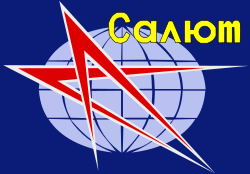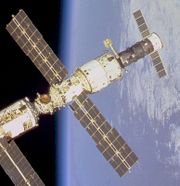Salyut program


The Salyut program (Russian: Салю́т, IPA: [sɐˈlʲut], Salute or Fireworks) was the first space station program undertaken by the Soviet Union, which consisted of a series of nine single-module space stations launched over a period of eleven years from 1971 to 1982. Intended as a project to carry out long-term research into the problems of living in space and a variety of astronomical, biological and Earth-resources experiments, the program allowed space station technology to evolve from the engineering development stage to long-term research outposts in space. Ultimately, experience gained from the Salyut stations went on to pave the way for multimodular space stations such as Mir and the International Space Station, with each of those stations possessing a Salyut-derived core module at its heart.
The program consisted of a series of six scientific research stations and three military reconnaissance stations, the latter being launched as part of the highly secretive Almaz program. Salyut broke several spaceflight records, including several mission duration records, the first ever orbital handover of a space station from one crew to another, and various spacewalk records. By the time the program concluded, in 1991, it had seen space station technology evolve from basic, single-docking port stations to complex, multi-ported orbital outposts with impressive scientific capabilities, whose technological legacy continues to the present day.
Contents |
Stations

The program was composed of DOS (Durable Orbital Station) civilian stations and OPS (Orbital Piloted Station) military stations. All were adapted from Vladimir Chelomei's original Almaz OPS spaceframe. For the military Orbital Piloted Stations modifications were small, and related to the rear docking port for Soyuz spacecraft. For the civilian DOS Orbital Space Station changes were great, with extra solar panels, rear and front docking ports for Soyuz spacecraft, TKS spacecraft and modules.
Salyut 1
Salyut 1 (DOS-1) (Russian: Салют-1; English: Salute 1) was launched April 19, 1971. It was the first space station to orbit Earth. Its first crew launched in Soyuz 10 but were unable to board it due to a failure in the docking mechanism; its second crew launched in Soyuz 11 and remained on board for 23 productive days. A pressure-equalization valve in the Soyuz 11 reentry capsule opened prematurely when the crew returned to Earth, killing all three. Salyut 1 reentered Earth's atmosphere October 11, 1971.
DOS-2
DOS-2 was launched on July 29, 1972. It was similar in design to Salyut 1. The second stage of its Proton rocket failed, which meant that it never reached orbit. It crashed into the Pacific Ocean.
Salyut 2
Salyut 2 (OPS-1) (Russian: Салют-2; English: Salute 2) was launched April 4, 1973. It was not really a part of the same program as the other Salyut stations, instead being the highly classified prototype military space station Almaz. It was given the designation Salyut 2 to conceal its true nature. Despite its successful launch, within two days the as-yet-unmanned Salyut 2 began losing pressure and its flight control failed; the cause of the failure was likely due to shrapnel piercing the station when the discarded Proton rocket upper stage that had placed it in orbit later exploded nearby. On April 11, 1973, 11 days after launch, an unexplainable accident caused four solar panels to be torn loose from the space station cutting off all power to the space station. Salyut 2 re-entered on May 28, 1973.
Cosmos 557
The Salyut space station that Almaz had substituted for, designated DOS-3, was launched on May 11, 1973, three days before the launch of Skylab. Due to errors in the flight control system while out of the range of ground control, the station fired its orbit-correction engines until it consumed all of its fuel. Since the spacecraft was already in orbit and had been registered by Western radar, the Soviets disguised the launch as "Cosmos 557" and quietly allowed it to re-enter Earth's atmosphere and burn up a week later. It was revealed to have been a Salyut station only much later.
Salyut 3

Salyut 3 (OPS-2) (Russian: Салют-3; English: Salute 3) was launched on June 25, 1974. It was another Almaz military space station, this one launched successfully. It tested a wide variety of reconnaissance sensors, returning a canister of film for analysis. On January 24, 1975 trials of the on-board 23 mm Nudelman aircraft cannon (other sources say it was a Nudelman NR-30 30 mm gun) were conducted with positive results at ranges from 3000 m to 500 m. Cosmonauts have confirmed that a target satellite was destroyed in the test. The next day, the station was ordered to deorbit. Only one of the three intended crews successfully boarded and manned the station, brought by Soyuz 14; Soyuz 15 attempted to bring a second crew but failed to dock. Nevertheless, it was an overall success. The station's orbit decayed, and it re-entered the atmosphere on January 24, 1975.
Salyut 4

Salyut 4 (DOS-4) (Russian: Салют-4; English: Salute 4) was launched on December 26, 1974. It was essentially a copy of the DOS-3, and unlike its ill-fated sibling it was a complete success. Two crews made stays aboard Salyut 4 (Soyuz 17 and Soyuz 18), including one of 63 days duration, and an unmanned Soyuz capsule (Soyuz 20) remained docked to the station for three months, proving the systems' long-term durability. Salyut 4 was deorbited February 2, 1977, and re-entered the Earth's atmosphere on February 3.
Salyut 5
Salyut 5 (OPS-3) (Russian: Салют-5; English translation Salute 5) was launched on June 22, 1976. It was the third and last Almaz military space station. Its launch and subsequent mission were both completed successfully, with three crews launching and two (Soyuz 21 and Soyuz 24) successfully boarding the craft for lengthy stays (the second crew on Soyuz 23 was unable to dock and had to abort). Salyut 5 reentered on August 8, 1977. Following Salyut 5 the Soviet Military decided that the tactical advantages were not worth the expense of the program and withdrew. The focus for the later missions was research and prestige.
Salyut 6

Salyut 6 (DOS-5) (Russian: Салют-6; English: Salute 6) was launched on September 29, 1977. Although it resembled the previous Salyut stations in overall design, it featured several revolutionary advances including a second docking port where an unmanned Progress cargo spacecraft could dock and refuel the station. From 1977 until 1982 Salyut 6 was visited by five long-duration crews and 11 short-term crews, including cosmonauts from Warsaw Pact countries. Some unconfirmed reports say the station was functionally capable of even more missions and years, but combating the ever-increasing mold in living quarters was becoming impossible, and in practice caused the retirement decision. The very first long-duration crew on Salyut 6 broke a record set on board Skylab, staying 96 days in orbit. The longest flight on board Salyut 6 lasted 185 days. The fourth Salyut 6 expedition deployed a 10-meter radio-telescope antenna delivered by a cargo ship. After Salyut 6 manned operations were discontinued in 1981, a heavy unmanned spacecraft called TKS and developed using hardware left from the canceled Almaz program was docked to the station as a hardware test. Salyut 6 was deorbited July 29, 1982.
Salyut 7

Salyut 7 (DOS-6) (Russian: Салют-7; English: Salute 7) was launched on April 19, 1982. It was the back-up vehicle for Salyut 6 and very similar in equipment and capabilities, though several more advanced features were included. It was aloft for four years and two months, during which time it was visited by 10 crews constituting 6 main expeditions and 4 secondary flights (including French and Indian cosmonauts). Aside from the many experiments and observations made on Salyut 7, the station also tested the docking and use of large modules with an orbiting space station. The modules were called "Heavy Cosmos modules." They helped engineers develop technology necessary to build Mir. Salyut 7 deorbited on February 7, 1991.
DOS-7

It was planned that two other stations (DOS-7 and DOS-8) would follow. These would be equipped with a total of four docking ports; two at either end of the station and an additional two ports on either side of docking sphere at the front of the station. DOS-7 continued to be developed, becoming the Mir Core Module, featuring better computers and solar arrays, accommodations for two cosmonauts each having their own cabin and six docking ports.
DOS-8

DOS-8 evolved into the Mir-2 project, intended to replace the Mir space station. Finally, it became the International Space Station Zvezda Service Module.
Data table
| Space Station |
Launched | Reentered | Days in orbit |
Days occupied |
Total crew and visitors |
Visiting manned spacecraft |
Visiting unmanned spacecraft |
Mass kg |
|---|---|---|---|---|---|---|---|---|
| Salyut 1 | April 19, 1971 01:40:00 UTC |
October 11, 1971 00:00:00 UTC |
175 | 24 | 3 | 2 | 0 | 18,500 |
| DOS-2 | July 29, 1972 | July 29, 1972 | 0 | 0 | 0 | 0 | 0 | 18,000 |
| Salyut 2 | April 4, 1973 09:00:00 UTC |
May 28, 1973 00:00:00 UTC |
54 | 0 | 0 | 0 | 0 | 18,500 |
| Cosmos 557 | May 11, 1973 00:20:00 UTC |
May 22, 1973 00:00:00 UTC |
11 | 0 | 0 | 0 | 0 | 19,400 |
| Salyut 3 | June 25, 1974 22:38:00 UTC |
January 24, 1975 00:00:00 UTC |
213 | 15 | 2 | 1 | 0 | 18,500 |
| Salyut 4 | December 26, 1974 04:15:00 UTC |
February 3, 1977 00:00:00 UTC |
770 | 92 | 4 | 2 | 1 | 18,500 |
| Salyut 5 | June 22, 1976 18:04:00 UTC |
August 8, 1977 00:00:00 UTC |
412 | 67 | 4 | 2 | 0 | 19,000 |
| Salyut 6 | September 29, 1977 06:50:00 UTC |
July 29, 1982 00:00:00 UTC |
1,764 | 683 | 33 | 16 | 14 | 19,824 |
| Salyut 7 | April 19, 1982 19:45:00 UTC |
February 7, 1991 00:00:00 UTC |
3,216 | 816 | 26 | 12 | 15 | 18,900 |
See also
- Almaz
- Mir
- Proton (rocket) launch vehicle
- Skylab
- International Space Station
- Space station for statistics of occupied space stations
References
External links
- Soviet Space Stations as Analogs - NASA report (PDF format)
- Mir Hardware Heritage
- Diaries of the Salyut missions
|
||||||||||||||||||||||
|
|||||||||||
|
||||||||||||||||||||||||||||||||||||||||||
|
|||||||||||
